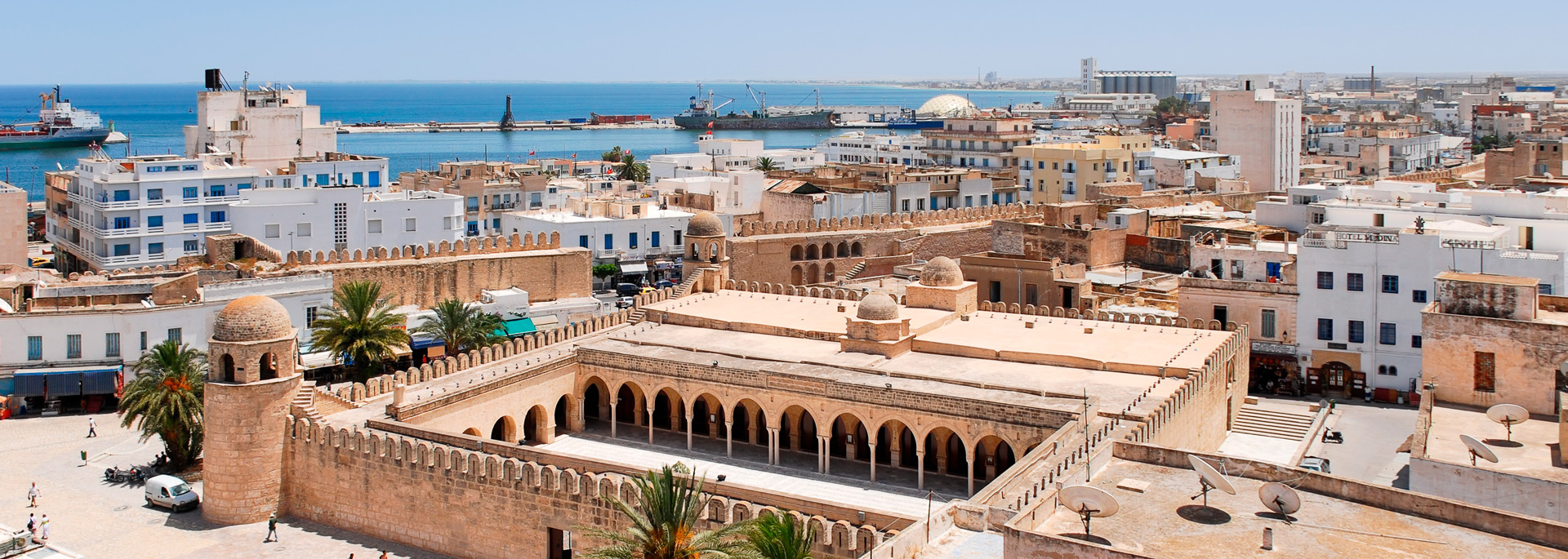

Sousse is the third largest city of Tunisia after Tunis and Sfax. It is located 140 km south of the capital Tunis, and it has around 220000 unhabitants. It is in the central-east of the country, on the gulf of Hammamet, which is a part of the mediterranean sea. Its economy is based on transport equipment, processed food, olive oil, textiles and tourism.
Sousse’s character had retained the solidly Arabian look and feel it had assumed in the centuries after Islam’s wars of conquest. Today it is considered one of the best examples of seaward-facing fortifications built by the Arabs. Its ribat, a soaring structure that combined the purposes of a minaret and a watch tower, is in outstanding condition and draws visitors from around the world.
Sousse retains a medieval heart of narrow, twisted streets, a kasbah and medina, its ribat fortress and long wall on the Mediterranean. Surrounding it, there is a modern city of long, straight roads and more widely spaced buildings.
Although Sousse is associated with olive oil manufacture and has other industries, tourism predominates today. An olive grove stretching over more than 2,500 square kilometres (965 sq mi), constitutes one of its main riches since Antiquity. A busy port, open to the town centre, adds a touch of liveliness to its activity.
Sousse is an important tourist resort. Hotel complexes with big capacity extend 20 km from the old city north along the seafront to Port El Kantaoui.
It is only 20 km from the international airport of Monastir.
The fine sandy beaches are backed by orchards and olive groves. It has a Mediterranean climate, with hot, dry summers and warm, mild wet winters. The seaside location moderates the climate, making it an all-season resort.
Some 1,200,000 visitors come every year.
اشتركوا في النشرة الإخبارية الشهرية لتصلكم آخر الأخبار.

Nam porttitor blandit accumsan. Ut vel dictum sem, a pretium dui. In malesuada enim in dolor euismod
Nam porttitor blandit accumsan. Ut vel dictum sem, a pretium dui. In malesuada enim in dolor euismod

Nam porttitor blandit accumsan. Ut vel dictum sem, a pretium dui. In malesuada enim in dolor euismod

Nam porttitor blandit accumsan. Ut vel dictum sem, a pretium dui. In malesuada enim in dolor euismod
Nam porttitor blandit accumsan. Ut vel dictum sem, a pretium dui. In malesuada enim in dolor euismod

Nam porttitor blandit accumsan. Ut vel dictum sem, a pretium dui. In malesuada enim in dolor euismod

Nam porttitor blandit accumsan. Ut vel dictum sem, a pretium dui. In malesuada enim in dolor euismod
Nam porttitor blandit accumsan. Ut vel dictum sem, a pretium dui. In malesuada enim in dolor euismod

Nam porttitor blandit accumsan. Ut vel dictum sem, a pretium dui. In malesuada enim in dolor euismod

Nam porttitor blandit accumsan. Ut vel dictum sem, a pretium dui. In malesuada enim in dolor euismod
Nam porttitor blandit accumsan. Ut vel dictum sem, a pretium dui. In malesuada enim in dolor euismod

Nam porttitor blandit accumsan. Ut vel dictum sem, a pretium dui. In malesuada enim in dolor euismod
| Cookie | Duration | Description |
|---|---|---|
| cookielawinfo-checbox-analytics | 11 months | يتم تعيين ملف تعريف الارتباط هذا بواسطة البرنامج الإضافي لموافقة ملف تعريف الارتباط الناتج عن اللائحة العامة لحماية البيانات (GDPR). يتم استخدام ملف تعريف الارتباط لتخزين موافقة المستخدم على ملفات تعريف الارتباط في فئة "التحليلات". |
| cookielawinfo-checbox-functional | 11 months | يتم تعيين ملف تعريف الارتباط من خلال موافقة ملفات تعريف الارتباط الخاصة باللائحة العامة لحماية البيانات (GDPR) لتسجيل موافقة المستخدم على ملفات تعريف الارتباط في الفئة "الوظيفية". |
| cookielawinfo-checbox-others | 11 months | يتم تعيين ملف تعريف الارتباط هذا بواسطة البرنامج الإضافي لموافقة ملف تعريف الارتباط الناتج عن اللائحة العامة لحماية البيانات (GDPR). يتم استخدام ملف تعريف الارتباط لتخزين موافقة المستخدم على ملفات تعريف الارتباط في الفئة "أخرى". |
| cookielawinfo-checkbox-necessary | 11 months | يتم تعيين ملف تعريف الارتباط هذا بواسطة البرنامج الإضافي لموافقة ملف تعريف الارتباط الناتج عن اللائحة العامة لحماية البيانات (GDPR). تُستخدم ملفات تعريف الارتباط لتخزين موافقة المستخدم على ملفات تعريف الارتباط في الفئة "ضرورية". |
| cookielawinfo-checkbox-performance | 11 months | يتم تعيين ملف تعريف الارتباط هذا بواسطة البرنامج الإضافي لموافقة ملف تعريف الارتباط الناتج عن اللائحة العامة لحماية البيانات (GDPR). يتم استخدام ملف تعريف الارتباط لتخزين موافقة المستخدم على ملفات تعريف الارتباط في فئة "الأداء". |
| viewed_cookie_policy | 11 months | يتم تعيين ملف تعريف الارتباط بواسطة البرنامج المساعد لموافقة ملف تعريف الارتباط الناتج عن القانون العام لحماية البيانات (GDPR Cookie Consent)، ويتم استخدامه لتخزين ما إذا كان المستخدم قد وافق على استخدام ملفات تعريف الارتباط أم لا. ولا يقوم بتخزين أي بيانات شخصية. |